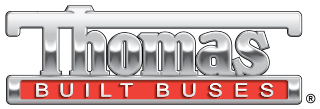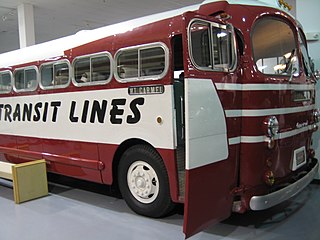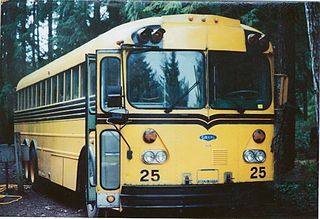
Kenworth Truck Company is an American truck manufacturer. Founded in 1923 as the successor to Gersix Motor Company, Kenworth specializes in production of heavy-duty and medium-duty commercial vehicles. Headquartered in the Seattle suburb of Kirkland, Washington, Kenworth has been a wholly owned subsidiary of PACCAR since 1945, operating alongside sister company Peterbilt Motors.
Plaxton is an English builder of bus and coach vehicle bodies based in Scarborough. Founded in 1907 by Frederick William Plaxton, it became a subsidiary of Alexander Dennis in May 2007. In 2019, the maker was acquired by Canadian bus manufacturer New Flyer which then became NFI Group.

Thomas Built Buses, Inc. is an American bus manufacturer. Best known for its production of yellow school buses, Thomas produces other bus designs for a variety of usages; currently, its production is concentrated on school buses and activity buses and their commercial derivatives.

Carpenter Body Works is a defunct American bus manufacturer. Founded in 1918 in Mitchell, Indiana, the company produced a variety of vehicles, with the majority of production consisting of yellow school buses for the United States and Canada.
Prevost is a Québec-based manufacturer of touring coaches and bus shells for high-end motorhomes and specialty conversions. The company is a subsidiary of Volvo.
DINA is a Mexican bus and truck manufacturer based in Ciudad Sahagún, Hidalgo, Mexico. It was created by the federal government of Mexico in 1951 as Diesel Nacional, S.A., and is currently owned by Grupo Empresarial G and its subsidiaries. The company has gone through several stages of production of freight and bus models throughout its history, thanks to technological and commercial agreements and partnerships with various companies such as Fiat, Renault, Marcopolo S.A., Flxible, Cummins, Perkins, Chrysler, Caterpillar, Scania, MCI, Škoda, Spicer, Eaton and Dana. Today its primary production is buses for urban domestic and foreign use. They have developed their truck technology with a subsidiary of BMW.

Aerocoach was a bus and coach manufacturer based in Chicago, Illinois, in the United States and was popular in the 1940s. The company existed between 1939 and 1952 when it went out of business. Its first manager was Harry Alphonse Fitzjohn, co-founder of the FitzJohn-Erwin Manufacturing Company.

The Crown Coach Corporation is a defunct American bus manufacturer. Founded in 1904, the company was best known for its Supercoach range of yellow school buses and motorcoaches; the former vehicles were marketed throughout the West Coast of the United States. Competing alongside Gillig Corporation and similar its Gillig Transit Coach, the two companies supplied California with school buses nearly exclusively into the 1980s.

Seddon Atkinson Vehicles Limited, a manufacturer of large goods vehicles based in Oldham, Greater Manchester, England, was formed after the acquisition in 1970 of Atkinson Vehicles Limited of Preston by Seddon Diesel Vehicles Limited of Oldham. In 1974, the firm was acquired by International Harvester, which sold it in March 1984 to the Spanish group Enasa which made it a subsidiary of Pegaso. In 1990, it became part of Iveco which used the brand for various types of specialised vehicles in the United Kingdom. The range of models produced included EuroMover, Pacer and Strato, which are aimed at refuse collection, recycling and construction operators.

Albion Motors was a Scottish automobile and commercial vehicle manufacturer.

The Eagle was a make of motor coach with a long and interesting history. During a period of over four decades, some 8,000 Eagle coaches were built in four countries on two continents. The coaches were a common sight on American highways and were strongly associated with Continental Trailways for over three decades.

Charles H Roe was a Yorkshire coachbuilding company. It was for most of its life based at Crossgates Carriage Works, in Leeds.
The SA was Toyota's first new passenger car design after World War II. It was the first in a family of vehicles before the introduction of the Crown. A series of light trucks also shared the chassis and major components of these passenger cars.

The Thomas Saf-T-Liner is the name of the transit-style school bus product line produced by Thomas Built Buses. Introduced in 1978, the Saf-T-Liner marked the transition to in-house chassis production by Thomas. In addition to school bus applications, variations of the Saf-T-Liner have been produced as activity buses, specialty vehicles, and commercial/transit buses. It can also be used to describe the Saf-T-Liner C2 or Saf-T-Liner FS-65, but they are not considered part of the Saf-T-Liner family.

The Gillig Transit Coach School Bus is a series of buses that were produced by the American bus manufacturer Gillig from 1940 to 1982. Alongside its namesake usage as a yellow school bus, the Transit Coach also served as the basis of motorcoaches and other commercial-use vehicles. Marketed primarily to operators on or near the West Coast of the United States, the Transit Coach competed nearly exclusively against the similar Crown Supercoach through much of its production.

Bus manufacturing, a sector of the automotive industry, manufactures buses and coaches.

The Blue Bird All American is a series of buses produced by American school bus manufacturer Blue Bird Corporation since 1948. Originally developed as a yellow school bus, versions of the All American have been designed for a wide variety of applications, ranging from the Blue Bird Wanderlodge luxury motorhome to buses for law enforcement use.

The Daimler Freeline was an underfloor-engined bus chassis built by Daimler between 1951 and 1964. It was a very poor seller in the UK market for an underfloor-engined bus and coach chassis, but became a substantial export success.

The Ford Transit Bus was a medium-duty transit bus produced by Ford from 1936 to 1947. The engine was originally placed at the front, but a rear-engine version replaced the original design in 1939. Ford constructed the chassis, which were then fitted with bodies constructed by the Union City Body Company of Union City, Indiana. Canadian versions were built from chassis fabricated in Windsor and bodies produced by Brantford Coach & Body, from 1941 to 1943.

A bruck is a type of bus or coach built to combine goods and passenger transport where it is most profitable or most convenient compared to separate vehicles. The word bruck was used in North America. In Australia they were known as passenger-freighters. In Europe they are known as Kombinationsbus (German), seka-auto (Finnish), kombibuss (Norwegian) and godsbuss (Swedish), with even the nickname skvader. They have for practical reasons mostly been built on front- or mid-engined chassis. In North America and Australia this type of bus was introduced in the late 1940s as a replacement for unprofitable railway lines, while in Europe they have been around since the first buses.

















